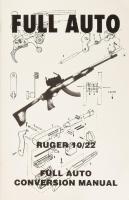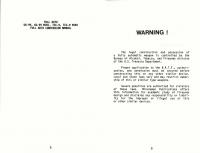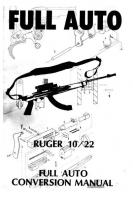Full Auto Ruger 10/22 Conversion Manual 0879472618, 9780879472610
Full Auto Ruger 10/22 Conversion Manual. Desert Publications. 1982.
131 69
English Pages 36 Year 1982
Recommend Papers
File loading please wait...
Citation preview
~ “FULL ‘AUTO CONVERSION MANUAL
Sequence
Of
Operation
A look through the accompanying drawings give the exact orientation and relationship
will
of the parts controlling
the firing
To achieve positive the
and reliable
trigger
group
10-22
was
redesigned
design HK-G3
of the Belgian FN-FAL battle rifle families.
weapon systems and reliability.
The
ed-bolt
modified
mode
When ing
(1)
1.
for
the
functioning,
select-fire
incorporating
are
basic
and West Both of
German these
legendary
in
still
retains
10-22
the
modified
of events
Ruger
the
of operation.
firing
sequence
cycle.
weapon,
performance
the
the
clos-
follow-
occur:
COCKING THE WEAPON
Assuming
there
is a loaded
magazine
in place,
the user retracts the bolt handle (and bolt assembly) which rotates the hammer rearward. This action compresses the recoil spring.
2. As the hammer almost completes its rearward rotation, the bottom of the hammer contacts the top of the disconnector which in turn pivots downward, releasing the sear to rotate upward into position against the hammer. The engagement between
this
the
hammer
time
and
because
the
sear
is
hammer
not
is
yet
set
fully
at
rotated
rearward.
3. During this same initial rearward movement of the bolt and hammer, the release lever and catch also move rearward slightly. The travel of these parts is limited by the ejector pin
which
is positioned
through
a slot
in the
release
lever. Both parts have independent’ torsion springs which forces them to rotate rearward. The stationary arm of these springs locates against the ejector pin. As the bolt and hammer complete their rearward travel, the engagement surface of the catch is against the hammer ready
to engage
the
4. When released. it
'burst'
notch.
the bolt is fully retracted, Recoil spring tension then
it is propels
forward.
5. At this from contact
same instant, the hammer (released with the bottom of the bolt) rotates
forward slightly and catch, (both respective
6. As a live
engagement
the bolt cartridge
to chamber
and securely engages previously positioned)
it.
the sear in their
notches.
is moving forward, it from the magazine and
strips begins
7,
At
a
given
point
just
before
completely, the top of the previously moved rearward)
release makes
the
bolt
closes
lever (having contact with
@ radiused slot machined in the bottom of the bolt. As the bolt continues forward motion, the release lever rotates forward. Through engagement with the catch by means of a laterally positioned roll pin, the release lever rotates the catch out of engagement with the hammer. (Both the catch and release lever pivot on a
common pin). At
(2)
this
point,
the weapon
is
ready
to fire.
SEMI-AUTO FIRE
1. The position
weapon is now in a loaded and cocked as established in the sequence above.
2. The safety should now be moved to the “OFF” position. (The safety is unaltered in this modification and functions identically as before. By moving the safety to “OFF,” the lower lug of the sear is provided with clearance to enable
downward 3. the
tion
travel
when
the trigger
is depressed).
The selector lever must be rearward, or “semi” position.
a
lug
on
the
bottom
of
pivot will be positioned in and will limit the upward section of the trigger.
bi
the
positioned in In this posi-
selector
lever
a downward position travel of the rear
4. Depress the trigger, thereby releasing the sear and hammer engagement. The hammer, under spring tension from the hammer spring, rotates forward striking the rear of the firing pin and detonating the cartridge. 5. The bolt, acting on the pressure generated during the resultant explosion of detonation, moves rearward, extracting and ejecting the fired cartridge case. 6. As the bolt moves rearward, the release lever moves as previously explained. As _ the bolt completes rearward travel, the disconnector
disengages the sear enabling it to for re-engagement with the hammer described).
be in position (as previously
7. Forward bolt travel performs the same functions as previously described. For another shot to be fired, the user must release the trigger and then depress it again to resume the sequence as described.
(3) 1.
FULL AUTO The
weapon
(as described 2. in
The
is
in
a
loaded
and
cocked
position
(as
described
in #1-7).
safety
is
moved
#2-2).
12
"OFF"
3. the
tion,
The selector lever must be forward or ‘BURST’ position.
the
lug
on
the
bottom
of
positioned in In this posi-
the
selector
lever pivot has rotated rearward enough to avoid contacting the upper, rear area of the trigger. The trigger in this position can be depressed further.
4. Fully depress the trigger, thereby releasing the hammer-sear engagement and resulting in mo of the cartridge (as described in #2-4). 5. The trigger remains depressed cycles rearward, extracting and fired case (as described in #2-5),
as the ejecting
6.
have
The
rearward
release
lever
(as described
and
catch
in #1-3).
bolt the
rotated
7. At the rearmost travel of the bolt and hammer, the disconnector pivots downward and releases the sear to pivot upward. However, because the trigger/sear assembly has rotated further down than it did in the “semi" mode, the sear is not high enough to engage the hammer. The Catch securely engages the hammer “burst notch,” thereby holding the hammer rearward as the bolt begins forward travel, stripping and chambering a live cartridge.
8. At the instant before the bolt closes completely, the release lever contacts the bolt, pivots forward and disengages the catch (as described in #1-7). This allows the hammer to strike the firing pin and detonate the cartridge.
13
This
is
cycle
released.
the hammer,
is
The
repeated
sear
and interrupt
can
14
until
then
the
rise,
trigger
intercept
the firing cycle.
SEMI-AUTO FUNCTIONING Selector is set at "SEMI". Bolt is in closed position. Hammer is cocked, sear engaged. Release lever and catch have pivoted Safety "ON".
*
Moving safety to “OFF” will fire weapon.
and
forward.
depressing
OPERATING SEQUENCE FULL SCALE DEWG
NO.
trigger
/4
FULL-AUTO FUNCTIONING Selector
is set at "BURST".
Safety
“OFF”.
Weapon
has fired and bolt
is moving
recoil spring tension. Trigger is fully depressed,
low enough
to not engage
Release lever and catch is engaging
catch burst
lowering
hammer.
have moved notch,
When bolt contacts and trips the catch assembly, the hammer falls ridge.
OPERATING FULL
SCALE
forward the
sear
rearward
nose
and
release lever and to detonate cart-
SEQUENCE DRWG
under
NO_
15
2 Parts
To Be Removed Semi-Auto
Due to the design and characteristics of the Ruger 10-22, it has been necessary to eliminate the use of the bolt lock, and bolt lock spring.
lever, and
This
was
release
pivot
originally All
pin
are
other
necessary
lever
occupy
spring,
located.
the
components
sion.
V
because
space
are
the
catch,
catch
where
used
in
these
this
release
spring,
parts
conver-
PARTS TO BE REMOVED FOR SELECT
#1 Bolt
Lock
FIRE
10-22 CONVERSION
#2 Spring
Bolt
18
Lock
3 Parts To Be
For 10-22,
select-fire conversion of the Ruger minor modifications to six parts of the
standard and
Modified
carbine
purpose
is
of each
Receiver-
required.
The
is described
Drawing
modifications
below.
# 1.
The receiver requires two 1/16" x .030 deep drilled detents, positioned in such a manner as to securely locate the position of the selector lever. Trigger Housing- Drawing # 2. The trigger housing requires
hole
be
drilled
cated, This catch/release
hole
and
through
the
that
housing
facilitates assembly lever assembly. Also,
9/16"
long
x
1/8"
wide
required as indicated to allow of the selector lever assembly.
Stock-
Drawing
a
as
1/8"
indi-
of the a 7/32"
slot
is
assembly
# 3.
e stock must be altered as shown to allow clearance for the selector lever assembly.
4,
Bolt- Drawing # 4, The bolt requires a slot or cut into the bottom as provides
a
for contact
5.
Trigger-
contact
with
surface
the
Drawing
to be machined indicated. This and
release
proper
timing
lever.
# 5.
e
trigger requires a small clearance cut to be made in the upper, rear portion near the disconnector pin hole. The web area
must be filed (as further rotation of
indicated) to provide the trigger assembly.
The drawing can be used as a location. Also, a small .150 is epoxied in position in the
template for x .030 shim slot at the
position
necessary
indicated.
limit the upward it disengages from Hammer-
Drawing
A “BURST” indicated.
assembled.
This
is
travel of the sear the disconnector.
to
when
# 6.
notch This
is
cut engages
20
into the
the
hammer catch
as when
!,050
!,000
oT RR
\
O Y
oN
O
*
—§/ 4/5Selector Drill
Positioning
1/16"
diameter
deep
RECEIVER —F A.
L FULL SCALE
DRWG_ 21
NQ_]
Detents x
.030
/
125
e— | 4350 —
ae
/]
He
(.9375) ——
Drill
562
Drill
7/32" (.2187)
right
trigger
diameter
here
hole through housing
Selector Assembly
1/8"
(.125)
dia-
meter hole through trigger housing (for
& Catch Pivot
only
is installed
by aligning the lugs and ector is rotated upwards
slot 90°.
TRIGGER HOUSING — FA, FULL SCALE DRWG_
in Trigger Housing and
inserting.
NO 2
Sel-
Inlet stock Assembly.
in
this
area
to provide
for Selector
STOCK FULL
SCALE
DRWG_
NO.
3
Depth of Slot
a | “N20 RADIUS + 2.975
aa
150
| i
—
\
|
MX
200 SN
SONS
Thickness
of
ee
.080
Slot
NS Diagonally shaded area of underside of bolt.
represents
the
flat
BOLT —F.A , SELECTIVE FIRE FULL SCALE DRWG. NO. 4 24
surfaces
NOTE The
bolt
ON BOLTS
design
for
the
Ruger
changed at some point. Below are of each. For this modification, be used
or
interchanged.
Old
Style
Bolt
New
Style
Bolt
25
10-22
was
shown examples each bolt can
ISO
File
X
web
Epoxy poxy
030
down
in
this
the
shim mini
thts
area.
TRIGGER FA, FULL SCALE
DRWG_NO.
— —, 750 -—
@ = “Tt
Jb (125) PIVOT PIN—CATCH LFULL SCALE | 26
REL. LEVER
area.
.025
90°
Burst
Notch
is
to be ground
HAMMER FA, |FULL SCALE
to
the
DRWG,
dimensions
NO.
6
shown.
4 Parts
for
The
To
Be
Manufactured
following
are
for
construction
select-fire
Materials
the
conversion
their
of
new
the
parts
are
Ruger also
required
10-22.
includ-
ed.
1.
Release
Lever-
Drawing
# 7.
The release lever is designed to be made from .050 thickness steel sheet metal. This part has a “tab” which is bent around almost
double,
providing
a
notch
for
location
of
the working arm of the release lever spring. The overall shape can be transferred by using the drawing as a template. The dimensioned areas should be as accurate as possible to ensure proper timing of hammer disengagement.
2.
CatchThe
Drawing
catch
# 8.
shown
can
be
made
by
bending
a
piece of .050 sheet metal into a channel shape of the proper width, and then filing the profile to match the drawing. A 3/32" x .510 roll pin is pressed through both
sides
of
a longer
the
pin
ed length.)
catch
through
as
and
indicated.
then
grind
(Press
to
finish-
Dimensioned
as
surfaces
possible
with
the
to
must
be
ensure
as
accurate
proper
engagement
hammer.
Spring-Release Lever- Drawing # 9. This torsion spring is to be made
music
wire
easily
or
made
an
equivalent.
with
a
little
from It
.030
can
practice.
be Use
a 1/8" approximate diameter rod clamped in a vise for an arbor. Cut about a 3" long piece of wire and clamp both ends with vise grips. When the approximate angle as shown in the drawing is achieved, release the spring and bend the two curves as shown. Cut spring arms to the approximate length as shown on the drawing.
4,
Spring-Catch-
Drawing
Same
in
as
above
Selector The
(if catch
Drawing
selector
thickness
stock
Lever-
lever
steel
available). as
used
If for
sufficient.
Selector
Positioning
lug
can
be
# 11.
can
spring
is
1s
# 10.
# 3.
made
be
made
stock,
neither the
Lugof
or is
release
Drawing any
from
.050
banding
available, lever
and
# 12.
available
steel
stock. To assemble in the selector lever, insert as shown and flatten the .125 x .060 diameter against the lever. The chamfer in the lever will allow the lug to mushroom and be securely fixed in place.
Selector Knob- Drawing # 13. The selector knob can be made
material
as
the
lug
in
#
7.
of
The
the
knob
same
is
knurled to provide a better grip. The .090 diameter x .040 “ball” firmly positions the selector assembly by mating with the indents in the receiver. To assemble the knob, either braze the knob in place, or
flare
the
3/16"
in chamfer position.
a
hole
1/8"
flare
the Use
the
knob
(.187)
diameter
lever after of a piece
in
the
center
securely.
into
the
the two are in rod with steel
as
a
punch
to
O50
Fold tab over to provide a notch for re-
lease lever spring.
| RELEASE LEVER FULL SCALE DRWG. NO. 7
Orill
3/32"
(.0937)
through catch Pin Location)
175
owvvyy
!
bd,
o/o—>
el i—
|
Drill 1/8" (.125) hole through catch
Y
!
S95
610
=.
N >
/ 3/32" diameter by .510 Roll
length
Pin
CATCH FULL
DRWG_
SCALE 33
NO.
8
(Roll
a4 .850
Be No Make springs from .030 diameter music wire. springs to approximate shape as shown.
SPRING — RELEASE LEVER FULL SCALE DRWG. NO.
9
Ft
.550
Nes
\— 140
SPRING — CATCH FULL
SCALE
DRWG. Mu
NO.
/O
Form
LO
oe
_- ee
yo (a) ye ¢ © —| je (187 45 (1875) /.250
he N
j
Ld
Chamfer
SFI FECTOR
125—>
EREe
Ye (125)
Lo)
FULL
'
.
|
¢
—>|-— 050
surfaces indicated -030 x 45°
JEVER
SCALE
DPRWG.
-—
NQ_L!
aa De “de
.500
a
aol loth iis250Jt ee ?
ene
3
“a
—>
O60
(2/87)
045
sreel kod
SELECTOR POSITIONING FULL SCALE DRWG
lax ty LUG NO Je
|
125
Flare this surface when assembled in Selector Lever
|SELECTOR FULL
ASSY
€
SCA/E
SEI.
DRWE_ 36
KNOB NO.
13
RELEASE l. 2. 3. 4. 5.
Release
Release
Lever
Lever
LEVER AND CATCH ASSEMBLY
Spring
Catch
Catch
Spring
Pivot Pin-Release
and
Lever
3
Catch
\
———
Sr
FRONT
~~
'A'This curved area on both springs is to be located against the rear side of the ejector pin, This provides tension on both = springs to
force
the
catch
and
release
7
lever
rearwards.
SOM
wWwNe
PARTS LIST Receiver
Trigger Guard Assembly Barrel Stock Receiver Cross Pins (2) Bolt Assembly Bolt Handle, Guide Rod, Spring Assembly Barrel Retainer Barrel Retainer Screws Barrel Band Magazine Trigger Housing Hammer Hammer Strut Hammer Spring
Hammer
Bushings
Hammer Hammer
Pivot Strut
Bye
and
Recoil
(2)
Pin Washer
Pin-Magazine
Latch and Ejector
in
Ejector Bolt Lock Spring Magazine Latch Plunger Magazine Latch Plunger Spring Bolt Lock Magazine Latch Safety Safety Detent Plunger Safety Detent Plunger Spring Trigger Trigger Plunger Trigger Plunger Spring Disconnector Disconnector Pivot Pin Sear Sear Spring
PARTS LIST CONTINUED Trigger Pivot Bolt Firing Pin Firing
Pin
Pin
Rebound
Firing Pin Stop Pin Extractor Extractor Plunger Extractor Spring Bolt Stop Pin
40
Spring
RUGER MODEL 10/22 CARBINE
4
10/22 CARBINE TRIGGER GUARD ASSEMBLY
2
‘
x
h39 “> 3332
10/22 CARBINE BOLT ASSEMBLY
42
‘
4 Whe
Desert Publications A division of the Delta Group
215 S. Washington El Dorado, AR 71730 U.S.A. [email protected]
ISBN 978-0-87947- 261-0 90000
9
"780879"47261
HL










